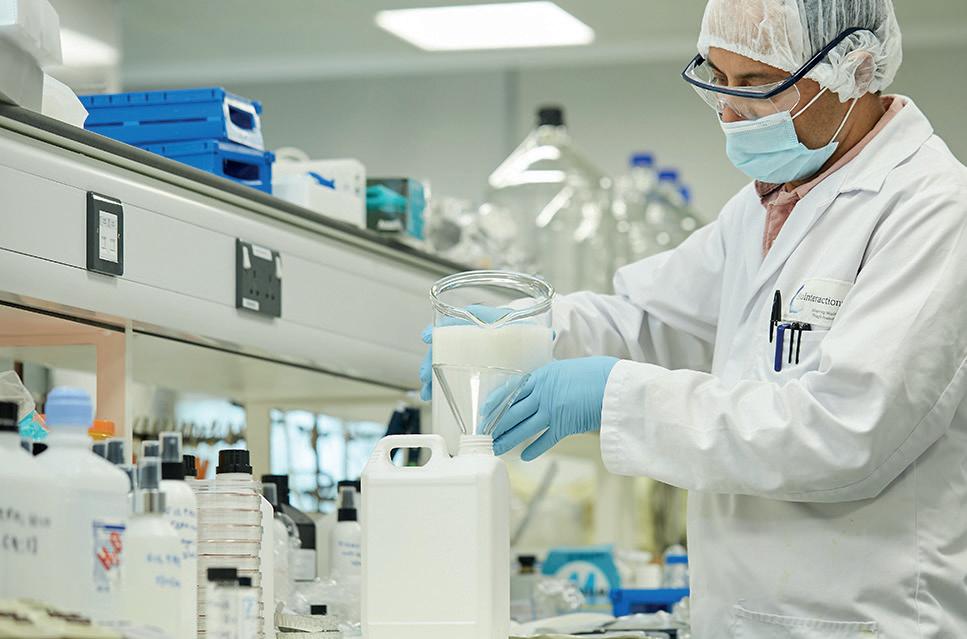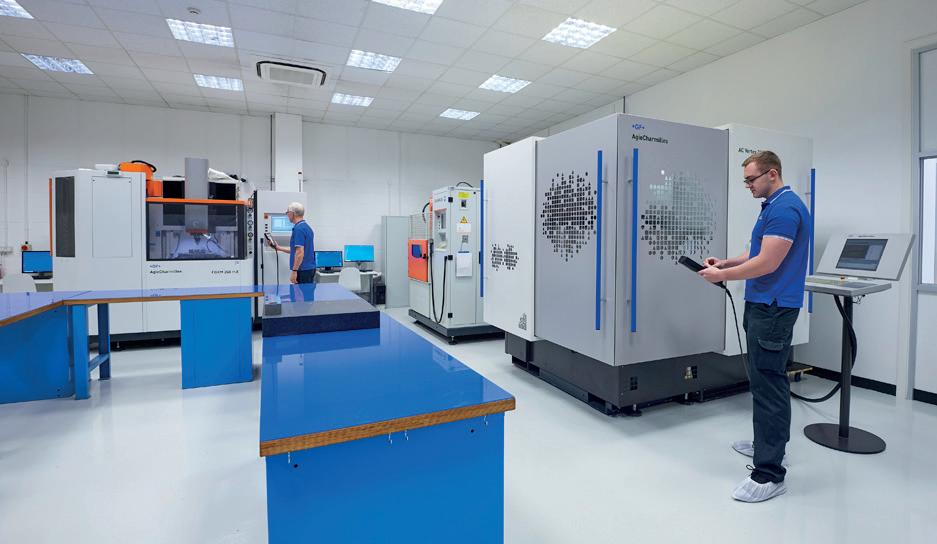
8 minute read
Dear market. What’s next? A peek into the near future of polymer-based solutions
For more than 70 years, polymer specialist Raumedic has partnered with companies and practitioners to develop solutions for medical and pharmaceutical applications.
As a development partner, manufacturer, and service provider, Raumedic has many experts at its disposal - constantly generating crucial market insights - not just by looking at data, but by cultivating and maintaining relationships with key stakeholders and decision makers in the market.
For this special edition of Med-Tech Innovation News, four of Raumedic’s experts agreed to share their most important learnings and personal foresights – and their implications for the industry.
CHRONIC DISEASES, HOME CARE, AND PATIENT COMFORT: RISING DEMAND FOR MINIATURISED COMPONENTS

Lena Wagner, product manager for drug delivery, said: “The projections for growth in the drug delivery market are impressive. But it’s more important to understand the mechanisms and factors that are driving this increasing demand. Multiple interconnected trends and phenomena are occurring simultaneously.

“First, there’s an unfortunate rise in chronic diseases all over the world. Diabetes is just one striking example of what is colloquially referred to as a “disease of civilisation.” Through globalisation and modernisation, sedentary lifestyles – along with other unhealthy lifestyle choices - are adopted by people in countries experiencing a rising standard of living.
Second, we’re witnessing the beginning of the era of home care. With ageing populations and demographic imbalances, we’re entering a time of elderly care on an unprecedented scale. This, in turn, will be a strain on public budgets. Home care might turn out to be a silver bullet. Through modern dosing and injection devices, therapies will require far fewer in-person treatments at the doctor’s office – providing a chance to rein in a possible future excess of public care costs. Further, most people prefer the option of remote therapies in the comfort of their own home.
Third, the rise of chronic diseases and home care have a common theme: the need for regular subcutaneous injections of pharmaceuticals – all while ensuring patient comfort. This often requires wearable medical devices with miniaturised components - as well as soft cannulas that don’t irritate patients when remaining under the skin for long periods of time.
That’s why, in my work at Raumedic, I’ve clearly witnessed a rise in demand for disposables for wearables as well as highly complex miniaturised components like drug channels. We also try to be ahead of the curve with innovations like our patented soft cannula from a single mould. It offers patients great comfort – and customers the potential of eliminating many process steps – as well as development and manufacturing costs.”
THE FUTURE OF SYRINGE PLUNGERS: NEW MATERIALS TO REPLACE RUBBER?
Simone Marquardt, key account manager: “Many people in medtech still take it for granted that syringe plungers are made of punched rubber as a default. However, I’m seeing a gradual but decisive shift in the market – a pivot away from rubber and towards new and innovative materials. And there are good reasons for it.
“Advanced materials contain fewer additives than rubber, significantly less extractables are being released when a drug is administered with a syringe. This goes a long way in preventing a negative impact on the formulation of the drug and the triggering of undesirable physical reactions in the patient's body.
“Further, the manufacturing process of stumping rubber has major disadvantages. It leaves behind particles that need to be washed off at great effort.
"With washing, in turn, there is a risk of cleaning residues reacting with the pharmaceutical during clinical usage.
“Talking about usage - I often get direct feedback from clinical personnel, attesting to what we have found out in an inhouse study at Raumedic: the improved handling properties of syringe plungers from new materials - vis a vis the rubber plungers - can literally be felt with one’s own hands.
“Another upside: These new materials can be processed via injection moulding, so anyone can have syringe plungers manufactured according to individual requirements and specifications. Thus, it’s no wonder that there’s more and more buzz about plungers based on these new material mixtures in the market.”
THE AUGMENTATION OF POLYMER TUBING BY DIGITAL AND SMART TECHNOLOGIES Martin Stoecker, product manager for Smartification: The world of medical and pharmaceutical tubing without "smartification" will soon be just as unthinkable as today's world of telecommunications without the smart phone.
But who will be put at an advantage by this? Contrary to what many might think, it’s not classical device manufacturers –but rather the niche specialists.
The business models of many medical device manufacturers are currently in a phase of transformation. In the future, companies won’t be able to maintain their market share by solely specialising in classic device technology.
By contrast, businesses combining expertise in the field of materials, electronic hardware and software will benefit from the smartification trend. Only by matching the digital with the material can smart applications with real added value be developed.
Specialist companies should thus primarily rely and expand upon their experience in their area of core competence – and then incorporate innovative digital potential into every possible process step. This allows them to stay ahead of the curve and push meaningful innovation into the market.
As polymer specialists, we have done so at Raumedic. One outcome is the patented “Integrated Tube Connector” (ITC), developed to measure parameters and record data at various points on a tube. Universally applicable, it can be connected to any medical and pharmaceutical tubing system.
Whether as a mono sensor or multi sensor device, whether with medium contact or without - the platform solution from Raumedic offers the potential for many different applications – e.g. steering life-support-machines based on parameters measured by the ITC and communicated to the larger machine via interface function.

FLUID HANDLING: PHARMA COMPANIES DIVERSIFYING SUPPLY CHAINS FOR TUBING
Nina Kaiser, head of sales Pharma: “The unprecedented disruptions of global supply chains is leading to adjustments in procurement strategies. Pharma- and biotech companies are not exempted from this – quite the opposite.





“While the availability of raw materials and finished fluid handling products was not a primary concern for a long time, the disruptions of a global pandemic and the permanent return of geostrategic power struggles have brought back longforgotten concerns of product availability and scarcity.






“At the same time, the demand for pharma fluid tubing is set to continue to grow at great rates. This offers rather unknown suppliers in the market a chance to become as second, third, or even fourth supplier.
“In many cases, original equipment manufacturers of pharma tubing are supplying larger companies who, in turn, re-sell the purchased tubing under their own brand. These kinds of manufacturers are often looking to diversify their customer base.





“Pharma companies seeking to diversify their supply chain are well-advised to seek out a supplier company that fulfills three criteria:
1. Proven competence in manufacturing pharma tubing for a well-known large pharma corporation that re-sold the product under their own name.
2. Long-standing agreements with suppliers of raw materials. This is usually the case with large and globally operating family-owned businesses with a culture of long-term thinking.
3. Spare manufacturing capacities to ensure quick implementation and general readiness.
Make your adhesive and dispensing processes more productive with process-optimising materials & systems

• Improve speed and accuracy of dispensing with dedicated dispensing robots

• Reduce work in progress with fast UV light curing materials

• Improve process simplicity with process-convenient materials packaging
• Get fast, homogenous mixtures of liquids, powders and pastes with mixing and degassing machines
• Achieve more consistent bonding results with plasma surface treatment
Could you reach your productivity potential by improving some of these areas? Read more at intertronics.co.uk/productivity.
01865 842842 info@intertronics.co.uk intertronics.co.uk/productivity
Give us a brief overview about 52North?
52North was founded in 2018 by four post-grads studying a range of disciplines at Cambridge. Our vision is to improve health outcomes and health equity by reinventing care pathways for all people across the world. NeutroCheck is in development by 52North which could significantly improve safety and quality of life for cancer patients at risk of sepsis.



We’ve received £1.3 million in pre-seed equity funding from investors, and £2.3 million in grant funding from Innovate UK, SBRI Healthcare and NIHR i4i, amongst others.
Last year, Prof Sir Leszek Borysiewicz (chair of Cancer Research UK) joined our board, and earlier this year, we became Macmillan Cancer Support’s first ever venture investment.
We’ve been on programmes like the Novartis BIOME, US Med-Tech Innovator, an innovation exchange programme at Cedars Sinai Hospital in LA and have been accepted on to an upcoming programme at Texas Medical Center.
We’re all about creating impact through innovation, while building the kind of organisation we would be proud to see our children working in.
You were part of the Start-Up Zone and PITCH at Med-Tech Innovation Expo last year, how was that experience? The event provided a fantastic platform to exchange ideas, build relationships, and expand our networks, and we were impressed by the range of topics covered in the sessions. Everyone there was passionate about their work, and there was a real sense of community and collaboration throughout.
PITCH was a great opportunity to showcase what we are doing in front of a knowledgeable audience, as well as to hear about the exciting things happening at other start-ups.
We are grateful for SBRI Healthcare’s invite to be part of the Start-up Zone. Also, we recruited somebody who we’d been speaking to but only had the opportunity to meet face-to-face at this event. She is now a key member of our team!

Tell us about the company’s journey since being founded in 2018?

It’s been a very exciting and fast-paced one. We have been constantly learning and growing, whether it's been about company governance, fundraising, recruitment, or regulation. It's been an incredibly rewarding experience to watch our company mature.
One key achievement has been building up our team from 1 to 13 people in just two years. This has enabled us to enter into two academic collaborations, one with Imperial College London and one with the University of Cambridge.
We’re also very proud of the development of NeutroCheck, which has gone from an idea to a sketch, to an initial prototype, and finally to a fully developed device and digital platform. We have co-created everything with patients and healthcare professionals along the way, which has added to our learnings and helped us to refine our product to meet the needs of the user.



We are excited about building a portfolio that will have a positive impact on patient care.

Tell us about how NeutroCheck came about?
My co-founder is an oncologist, who sees patients undergoing chemotherapy treatment. He saw what a huge impact the current pathway for neutropenic sepsis had on quality of life for people living with cancer. We knew immediately that this was something that we wanted to solve.
What effect can it have on healthcare resources?
Introducing NeutroCheck could have a significant impact on healthcare systems across the world. In the UK, it could prevent around 50,000 unnecessary A&E visits each year, allowing clinicians to focus care where on those who are at-risk. By enabling the earlier identification of at-risk patients, it would also provide an opportunity to give early antibiotics, and thereby save hundreds of lives each year.
What else is on the horizon for 52North Health?
We’re growing our digital product offering and are excited to be working with new Trusts across the UK. There’s probably not too much more I can say, except to say that we’re always up to exciting things!










